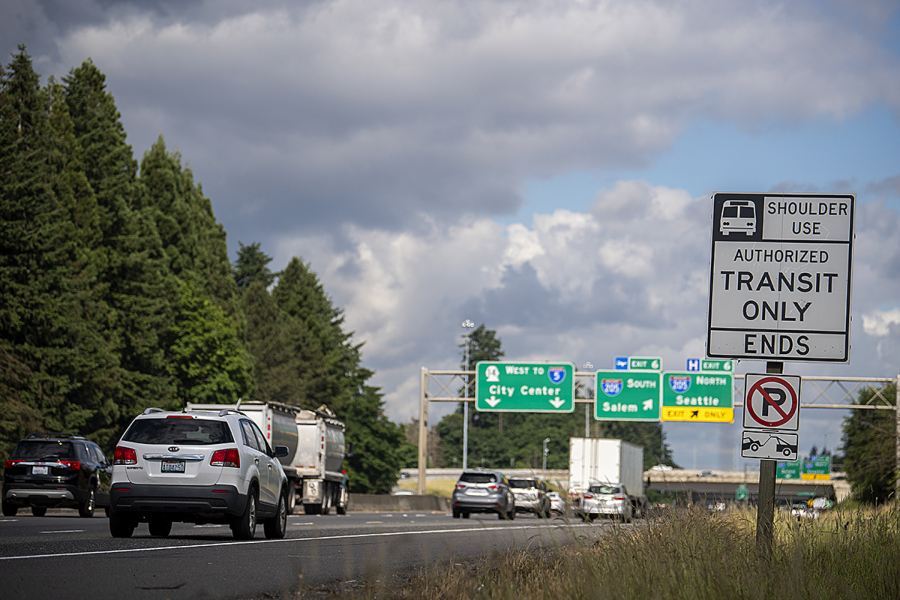C-Tran is poised to take its first step toward electrifying its bus fleet. The agency’s board of directors voted Tuesday to authorize the purchase of eight new battery-electric buses to replace eight of the fleet’s oldest diesel models.
The purchase contract — priced at a maximum of about $9.74 million — includes eight 40-foot battery-electric buses and associated charging infrastructure from Gillig Corp.
C-Tran tested a loaner electric bus in 2014, but the new purchase agreement marks the first time the agency will put fully electric buses into regular operation. The current fleet consists of 117 transit buses, 66 of which are hybrids.
Range question
Plans for the purchase were announced in 2019, partly funded by revenue from a pair of settlements in the Volkswagen diesel emissions cheating scandal. The original plan called for an order of 10 buses; C-Tran plans to order the remaining two in 2024.
The standard Gillig battery-electric bus model was unveiled in 2019 and entered production last year. It uses a modern low-floor configuration and is powered by a 444-kilowatt-hour battery, which the company claims translates to a theoretical range of 210 miles per charge and a real-world range of 150 miles.
TriMet recently purchased five of the same model and took delivery of the first bus in March. The agency also operates five battery-electric buses from manufacturer New Flyer, which use an overhead charging system at Sunset Transit Center near Beaverton to top the buses off midrun.
Similar midroute charging installations could be possible for C-Tran in the future, chief executive officer Shawn Donaghy told the board. But this initial round of infrastructure will focus on overnight charging, with the expectation that the Gillig buses will run all day on a single charge. Donaghy said C-Tran is anticipating a practical range of about 125 to 150 miles per charge, so it’s going to start by using the buses on its shorter routes.
“Really, the length of time that a bus can be out on the street is dependent on seasons, and it’s dependent on terrain,” he said.
Electric buses would need about 325 miles of range to be able to cover any C-Tran route, according to Chris Selk, director of communications and customer experience.
Bus on shoulder
Tuesday’s board meeting also focused on an upcoming change to C-Tran’s bus-on-shoulder pilot program along state Highway 14. The board ultimately voted to authorize a letter of understanding with the Washington State Department of Transportation outlining the new operating rules for buses in the corridor, but the plan drew negative comments from several board members.
C-Tran reached an agreement with WSDOT to begin the pilot program four years ago. It gives bus drivers the option to use the shoulder of state Highway 14 to bypass heavy traffic from Interstate 205 to Southeast 164th Avenue, near the Fisher’s Landing Transit Center.
An upcoming WSDOT project aims to address overall congestion in that stretch by adding a third travel lane in each direction and building a new westbound “peak-use shoulder lane” that can be used as a fourth regular traffic lane during congested conditions. Electronic signs will indicate when the lane is open.
Donaghy noted that WSDOT had raised safety concerns that C-Tran needed to solve when it began the pilot shoulder program, and he said the transit agency’s success has served as proof-of-concept for rush-hour shoulder driving.
“Now that they’ve seen the benefit that C-Tran has on bus-on-shoulder, they would like to borrow some of that space back,” he said.
The new all-purpose shoulder would replace C-Tran’s current pilot program. Buses would still retain the exclusive ability to use the shoulder as needed during off-peak hours, but other vehicles would be allowed during rush hour — a change that drew the ire of board member Ty Stober.
“Our buses are going to be competing with regular vehicles in this lane?” he asked. “How does that help transit usage?”
Donaughy and C-Tran chief capital projects and planning officer Scott Patterson replied that WSDOT’s budget and right-of-way width limitations ruled out a bus-only shoulder lane.
Patterson also noted that the success of the state Highway 14 bus-on-shoulder program has led to the introduction of additional bus-on-shoulder segments on Interstate 5 southbound through Vancouver and on the Interstate 205 Bridge.
“There may well be times where we have a slight increase in travel time (on state Highway 14), but that slight increase will be more than offset by the added benefit that we’re going to see across the 205 bridge,” he said.
Stober and board chair Anne McEnerny-Ogle continued to object, although McEnerny-Ogle noted that C-Tran’s original pilot agreement with WSDOT did give each agency the right to unilaterally end the program. Stober argued that the added benefits on I-205 shouldn’t come at the cost of bus prioritization on state Highway 14.
“This is a major political fumble for WSDOT,” he said. “This feels like it’s out of left field.”




